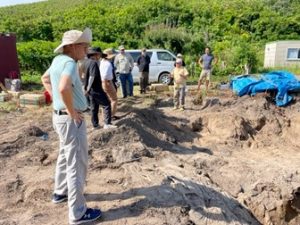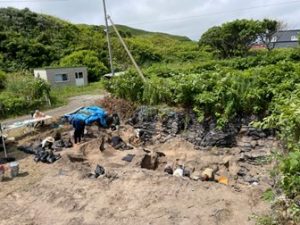Memoir (23) by Professor Joe Watkins, University of Arizona, USA
Process and teaching
On Monday, July 31, 2023, participants from Scotland, Mexico, Japan, China, Taiwan, and the United States set off for the Rebun Island International Archaeological Field School (part of the Hokkaido University’s Summer Institute). They made their way from Sapporo by train, bus, and ferry to Japan’s Rebun Island, located northwest of the main island of Hokkaido. Tourists flock to Rebun Island for its alpine wildflowers, seafood, and kombu. For three weeks this year, students and staff will call Rebun Island home as archaeological excavations are begun again after a three-year lapse due to the COVID-19 pandemic.
Excavations will resume at the Hamanaka 2 site, an archaeological site that has a stratified occupation sequence extending from the Late Jomon to the Historical Ainu period, a period covering more than 3,000 years. The cultural deposit, from the bottom to the top, is more than 3 meters thick.
Students attending the field school will learn the basics of archaeological investigations. They will learn the proper way to excavate the deposits, how to recognize cultural artifacts and culturally modified objects, and the proper way to clean and curate those materials. Graduate students will gain the opportunity to teach undergraduate students and to conduct research of their own that relates to the archaeological site. Visiting scholars and Summer Institute instructors will give lectures to the students about the archaeology of the area, the deeper history of the area’s inhabitants, and other topics of general archaeological interest. In between the excavation days, participants have the opportunity to visit locations on the island to take in its scenic beauty and local cuisine.
Those of us who have been here for previous field schools have missed being here, and the local inhabitants have missed us as well. In terms of the archaeological record, three years is nothing; in terms of the Rebun Island International Field School, three years has been a lifetime!
 Egret fishing in the evening light (photograph by Joe Watkins).
Egret fishing in the evening light (photograph by Joe Watkins).
 Awaiting instructions for first day site cleanup (photograph by Carol Ellick).
Awaiting instructions for first day site cleanup (photograph by Carol Ellick).
 Day one: cleaning off the accumulated dirt of three years’ inactivity after protective sandbags have been removed (photograph by Joe Watkins).
Day one: cleaning off the accumulated dirt of three years’ inactivity after protective sandbags have been removed (photograph by Joe Watkins).


